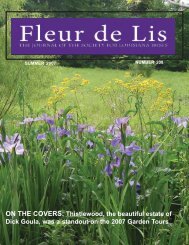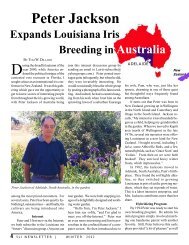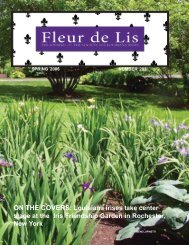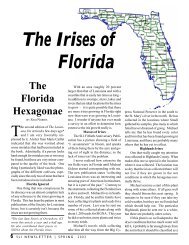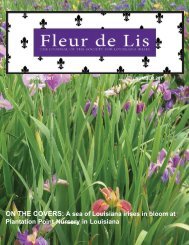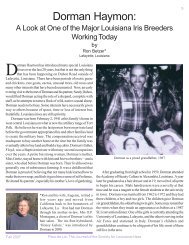SLI Fall 2004 - Society for Louisiana Iris
SLI Fall 2004 - Society for Louisiana Iris
SLI Fall 2004 - Society for Louisiana Iris
Create successful ePaper yourself
Turn your PDF publications into a flip-book with our unique Google optimized e-Paper software.
4Summer 2006‘Big Tex’ ‘Crushed Ice’ ‘Amber River’‘Enviable’‘Gold Plaque’‘Charlotte’s Tutu’this garden, if maintained, will be a “must see” in futureyears during the <strong>SLI</strong> convention.Bois d’Arc Gardens:Those who have grown <strong>Louisiana</strong> irises <strong>for</strong> severalyears will tell you that Bois d’Arc is one of the pioneers.Rusty and Ed Ostheimer began growing irises as a hobbyin 1961 and were associated with <strong>SLI</strong>, in one capacityor another, over all these years. Their hobby became abusiness in 1983 when they founded Bois d’Arc Gardens.Following the untimely death of Ed, Rusty foundthat she simply could not continue the business along.Bud McSparrin, a friend of Rusty and Ed <strong>for</strong> 40 yearsoffered to help her get things under control. He musthave been more than successful with his help, since theymarried a few years later.Bois d’Arc was a very interesting garden. Unlike theLandry garden, it’s strictly a commercial affair. The irisesare planted in beds approximately 6 feet by 200+ feetand cover approximately five acres. All beds were wellmaintained and, given the size of the garden, exceptionallyclean. In addition to beds, Rusty and Bud are alsoexperimenting with container grown irises. The gardenfeatures species, named cultivars and seedlings asguest irises. This garden is also a great source <strong>for</strong> thosewith a love <strong>for</strong> the older “historical” <strong>Louisiana</strong> irises.A very interesting experiment was in progress at Boisd’Arc in cooperation with <strong>Louisiana</strong> State University.Rusty and Bud donated a large bed of <strong>Louisiana</strong> irises<strong>for</strong> an experiment in weed control by the University. LSUpersonnel had treated small segments of the bed withvarious herbicides and combinations of herbicides underdifferent conditions in an attempt to find some process<strong>for</strong> controlling weeds in <strong>Louisiana</strong> irises without anadverse effect upon the plants. I can’t recall what constitutedthe successful treatment, but they might have foundthe secret since Bois d’ Arc, when Bud arrived on thescene, had a tremendous problem with weeds and wildblackberries.Bloom at Bois d’Arc was very slightly beyond peak,but what a sight!! Five acres of <strong>Louisiana</strong> irises in bloomcan’t be described on paper.Conclusion:Given that the <strong>SLI</strong> convention is held frequently inLafayette, it becomes difficult <strong>for</strong> the local planners toschedule tour gardens without becoming repetitive. I don’trecall having visited these gardens be<strong>for</strong>e, but I certainlywouldn’t be disappointed to return to any of them in thefuture. It was truly an enjoyable day in three beautifulgardens.Harry Wol<strong>for</strong>d is vice president of the<strong>Society</strong> <strong>for</strong> <strong>Louisiana</strong> <strong>Iris</strong>es. Retired froma long career in education, Harry and hiswife, <strong>SLI</strong> board member Donna Wol<strong>for</strong>d,live in Palm Bay, Fla.More convention photos will be featuredin the <strong>Fall</strong> issue of Fleur de LisFleur de Lis: The Journal of the <strong>Society</strong> <strong>for</strong> <strong>Louisiana</strong> <strong>Iris</strong>es
Summer 2006 5FAVORITE FLOWERS SEEN ON TOUR. . .Reflections from the 2006 <strong>SLI</strong> Tour of GardensPAUL GOSSETTTulsa, OklahomaWhich irises caught the attentionof the <strong>SLI</strong> President andothers on the tour? Find outin this article.©Nyla HughesWell, 7:00 a.m. came very early on Friday, April7, 2006, as everyone was gathering to boardthe <strong>Society</strong> <strong>for</strong> <strong>Louisiana</strong> <strong>Iris</strong>es tour bus tohead south out of Lafayette to the Houma, <strong>Louisiana</strong>area. On the garden tour <strong>for</strong> this year are three gardens,the Murray Landry Garden, Houma Area Convention andVisitors Center, and Bois d’Arc Gardens of Rusty & BudMcSparrin.We arrived with a big greeting from Murray Landry.Mr. Landry grows his 100 cultivars of <strong>Louisiana</strong> irises incontainers in various places in his beautiful garden. Seengrowing very well in the garden were: ‘Praline Festival’(Haymon 1992) a cream, heavily veined dusted rose tanwith yellow gold signal; ‘Festival Acadian’ (Haymon 1990)red purple standards, falls slightly darker red purple witha yellow signal; ‘Jeri’ (Bertinot 1985) a velvety dark violet©Nyla HughesJoy and Murray Landry with guest during the <strong>SLI</strong> Tour of Gardens‘Rokki Rockwell’purple with citron line signal; ‘News Brief’ (Rowlan 1983)red standards with crimson falls, lime signal; ‘RokkiRockwell’ (Haymon 1992) a beautiful medium yellow withgold line signal; ‘Teddy Bear’ (Arny 1976) a copperbrown with gold line signal; ‘Hurricane Colin’ (O’Connor1993); Rose orange with yellow signal; ‘WindowShopping’ (Morgan 1993) Light yellow standards, darkred falls with light yellow signal; and ‘Empress Josephine’(Haymon 1990) a very velvety dark red violet with brightgold signal.We left the Landry Garden and headed <strong>for</strong> the HoumaArea Convention and Visitors Center. The garden isbeautifully laid out and was well care <strong>for</strong>, but it was pastpeak bloom. Seen growing were ‘Professor Jim’(Mertzweiller 1987) a medium red, veined dark red violetwith yellow signal; ‘Flareout’ (Granger 1992) cartwheelfalls, light blue with greenish white center; ‘Claire deLune’ (Unknown 1965) a purple violet; and ‘PrincessAnna Marie’ (Musacchia 2006) violet self with whiteunderlay around yellow blaze signal.Next and last stop <strong>for</strong> the day was at Bois D’ArcGardens, owned by Rusty and Bud McSparrin. We hadlunch here be<strong>for</strong>e touring the garden; we also observedFleur de Lis: The Journal of the <strong>Society</strong> <strong>for</strong> <strong>Louisiana</strong> <strong>Iris</strong>es
©Nyla Hughes6Clumps of <strong>Louisiana</strong> irises surround a small pond a Bois d’Arc Gardensa presentation by <strong>Louisiana</strong> State University personnel on weedcontrol. Seen growing in the garden were ‘Feliciana Hills’ (O’Connor1992) a very beautiful pink self with dark pink around yellow signal;‘Poverty Point’(O’Connor 2000) amedium rose colored flower witha large yellowarrowhead signal;‘Willow Mint’ (Morgan 1995) ayellow with greeninfusions in thecenter of the petalsand with a greensignal and style arms; ‘SwampMonster’ (K. Durio Registered 1992)standards violetwith pale violetedge, yellow ‘Hurricane Colin’ signal; ‘Ardoyne’(Musacchia 2005) pale lavender standards, falls purplish lavenderwith yellow signal; and ‘Bayou Tiger’(Strawn 1996) red purplestandards, yellow style arms, greyed orange veined darker falls withorange signal.What a wonderful garden tour of an area that had survivedHurricanes “Katrina” and “Rita” with little damage. I give A BIGTHANK YOU to all of the garden hosts and to everyone that wasinvolved with taking care of the gardens and with hosting <strong>SLI</strong>. Thankyou all!©Nyla HughesPaul Gossett, a resident of Tulsa, Ok., ispresident of the <strong>Society</strong> <strong>for</strong> <strong>Louisiana</strong> <strong>Iris</strong>es.Retired from the petroleum industry, Pauldevotes time to many aspects of the irisworld—including service on the American <strong>Iris</strong><strong>Society</strong> board.Summer 2006The <strong>SLI</strong> Presentationat AISEditor’s Note: Harry Wol<strong>for</strong>d, <strong>Society</strong> <strong>for</strong><strong>Louisiana</strong> <strong>Iris</strong>es vice president, gave apresentation on behalf of the <strong>Society</strong> at theannual convention of the American <strong>Iris</strong> <strong>Society</strong>in Portland, Oregon in May. Harry, who hasbeen collecting digital images of <strong>Louisiana</strong>irises <strong>for</strong> years and is the main person behindthe <strong>Society</strong>’s digital checklist, provided thefollowing report on the presentation.The AIS scheduled the <strong>SLI</strong> presentation<strong>for</strong> 7:30 in the morning. This caused a greatdeal on concern on my part. Who, in theirright mind, would care to attend apresentation on <strong>Louisiana</strong> irises at that hour?Surprise! A count in the room approached100 “iris nuts” ready <strong>for</strong> the gospel!The Power Point presentation was entitled“Under Construction” and consisted of 100recently obtained seedling pictures. In fact,some were “obtained” via e-mail the nightbe<strong>for</strong>e I departed <strong>for</strong> Portland, and were“plugged into” the presentation in the weehours of the morning. These late arrivalswere from Dr. T. John Betts and Heather Pryorin Sydney, Australia and included some oftheir latest creations from the 2006 bloomseason.The presentation contained recentseedling pictures from seven hybridizers, withHeather Pryor and Peter Jackson of Australiaproviding the most images. Those inattendance appeared well pleased with theirdecision to skip the morning coffee and attendthe presentation.Following the Power Point portion of thepresentation, there were many goodquestions dealing with the cultivation andcare of <strong>Louisiana</strong> irises. We also sold allcopies of the digital checklist we had available,and Paul Gossett sold a number ofmemberships. It was obvious from the gist ofthe questions that the <strong>Louisiana</strong> irises aregaining a solid foothold in the iris-growingcommunity.But 7:30 a.m.!!!—Harry Wol<strong>for</strong>dPalm Bay, FloridaFleur de Lis: The Journal of the <strong>Society</strong> <strong>for</strong> <strong>Louisiana</strong> <strong>Iris</strong>es
Summer 2006A PROFILE OF AN IRIS HYBRIDIZERWAYLAND RUDKINSacramento, Cali<strong>for</strong>nia7Follow the path of the authoras he develops into alouisiana iris hybridizer.When I graduated from Tracy Hi in 1942 I hadno idea I would be hybridizing irises when Iwas 80. However, there should have beensome clues. The Busch and Lomb Science Award wasgiven to me <strong>for</strong> taking four years of science classes. Myfather, wanting to teach me about the birds and bees,arranged to get me on a field trip with a almond growerand his daughter. We went to the University of Cali<strong>for</strong>niaat Davis to learn how to pollinate fruittrees.Even though America was at war in1942, I entered Stockton Junior Collegeto begin pre-dental studies. Aftercompleting one semester, I was shippedoff to boot camp in Idaho. Aftercompleting Hospital Corp school anddental technician school, I found myselfback on the Stockton Junior Collegecampus. This time, I was enrolled inCollege of The Pacific, living in thesorority house taken over by the USNavy V 12 unit. Since my eyes and ears did not qualifyme to become a naval officer, I was sent to the SouthPacific at the end of the semester. I did enjoy the flowersof New Guinea, and I was particularly impressed withthe hibiscusAt some point Virginia started buying iris rhizomesfrom Schreiner’s. I started hybridizing tall bearded in1985. Growing irises 20 miles from home turned out tobe a bad idea. Selection of seedlings requires more thanonce-a-week evaluation. When I retired in 1989, we gotinvolved with the local farmers market and became knownas Rudkins’s <strong>Iris</strong> Patch. We had a display garden athome and filled orders. It was a nice hobby business.However going to the markets on almost a daily basismade it very labor intensive, and left little time <strong>for</strong> cultivarevaluation. We became active in the Sacramento <strong>Iris</strong><strong>Society</strong> in 1989.In 1994 my wife and I offered to take Mary Dunn, thewell known hybridizer of <strong>Louisiana</strong> irises, to Portland <strong>for</strong>the American <strong>Iris</strong> <strong>Society</strong> convention. She was pleasedwith the invitation, and since this was our first nationalconvention we were doubly pleased. We were happy tochum with Judy Mogul and Lynn Finkel, and listen in whilethey picked Mary’s brain.Of the many <strong>Louisiana</strong> irises that Mary gave me, myearly favorite was ‘Dominique’ (Dunn 86). One morning Ispotted a two year clump in full bloom. The three distinctlayers of red blooms gave me the thrill of being back in atropical <strong>for</strong>est. I immediately made a self-cross of thoseirises. Mary got quite excited when I told her that thiscross produced only one large seed. Whenthe plant from that single seed bloomed, itlooked a little like the parent, but perhaps, adeeper red and a little smaller. While this wasin bloom I spotted my specimen of ‘BayouMystique’ loaded with blooms. This was notmy favorite flower but it sure had lots ofblooms, so I crossed it with my new seedling.Of the 32 plants produced, my favorite wasa deep maroon I was amazed at the qualityand diversity of the offspring.These were the 99-1- line.Seedling 99-1-0R won “Best Seedling by ahybridizer outside Region 15” at the Region 15 SpringTrek in Tucson, Az., April 23, 2005. It is registered as‘Our Sassy’ and is being introduced.The ‘Ginny’s Choice’ storyOne year, while trying to scrounge up some pots, Idumped the left over soil from my seedling pots into fivegallontree pots. The next year I needed some plantingsoil, so I headed <strong>for</strong> the five gallon pots. I was surprisedto find seeds germinating all through the pots, even twofeet deep. Of course, these were all planted.The 2002 AIS Region 14 convention was held inSacramento, so it was easy <strong>for</strong> me to take seedlings tothe show. Virginia insisted that I take 99-99-1, a blueFleur de Lis: The Journal of the <strong>Society</strong> <strong>for</strong> <strong>Louisiana</strong> <strong>Iris</strong>es
10Summer 2006WHAT A GIFT FROM AUSTRALIA!JOHN TAYLOR’S ‘GLADIATOR’S GIFT’ IS A RECORD-SETTERT. JOHN BETTSNew South Wales, AustraliaMany irises hybridized byAustralians have been theprogenitors of some of themost popular <strong>Louisiana</strong> irises.No iris has been used as effectivelyin hyrbridizing neweririses than ‘Gladiator’s Gift.’Irecently ordered two <strong>Louisiana</strong> irises in an out-ofseasonsale, one a yellow bred in the USA, and theother an Australian purple. Checking on theirparentage, I was interested to find that both had JohnTaylor’s brownish purple ‘Gladiator’s Gift’ (Taylor, 90) asa parent. I decided to investigate howcommonly ‘Gladiator’s Gift’ [hereinafterreferred to as GG] appears in thebackgrounds of newer registrations.I found GG in a considerable numberof registrations from 1994 to 1999,particularly among Australianintroductions. These continued into thenew century, with one in 2003. Afterreceiving a High Commendation in1989, GG was named and introduceda year later. I discarded it as being drab,small and too ruffled, but others saw ithad virtues and used it as a successful pod or pollenparent—and some of its progeny have been goodbreeders, too.Bernard Pryor, a hybridizer from the Sydney, Australiaarea, has selfed GG to yield two of his shorter“watersprite” varieties, the tan ‘Little Nutkin (1994) andcaramel-rose ‘Little Treasure’ (1997). Mary Dunn’sselfing of GG produced ‘Broad Daylight’ (2002,registered by Ghio), a gold.Heather Pryor launched into breeding <strong>Louisiana</strong>irises with great enthusiasm in 1990, and her 40 th crosswas ‘Alluvial Gold’ (Taylor, 91) X GG. This yielded smallgold ‘Bushfire Moon’ (1994), ‘Lemon Sorbet’ (1995),‘Lemon Petticoat’ (1996), and ‘Ginger Fudge’ (1997).Harry Wol<strong>for</strong>d used the reverse cross in 1998 to obtainsmoky mauve ‘Gloria Blake’ (2002).Heather Pryor’s 55 th cross that year was GG X thecreamy ‘Designer’s Dream’ (Taylor 91)—which producedthe celebrated small, dark, and very ruffled ‘Garnet StormDancer’ (1994); the rose colored ‘Now Hear This’ (1994);the prolific yellow ‘For Dad’ (1996); the lemon ‘CanaryDuet’ (1998); and the yellow ‘Citronic’ (2003). Her 56 th1990 cross was the reverse (‘Designer’s Dream’ X GG),which gave a slower response with small yellow ‘NewVogue’ (1997); the white ‘Te Aroha’ (1997); the small darkmaroon ‘Simply Irresistible’ (1998), and the gold‘Meteoric Rise’ (1999).Heather’s most productive pollination in 1990 washer 60 th cross—GG X ‘Desert Jewel,’ a subdued washedpurple. Two early namings were in 1994, thereddish ‘Jazz Hot’ and brown-veined yellow‘Volcanic Wildfire.’ The next year brought fivemore, including the <strong>2004</strong> DeBaillon Medalwinner, a ruffled reddish ‘Hot and Spicy’ (1995).The other four are the purple ‘Fighting Spirit,’complicated rose colored ‘Joie de Vivre,’ thedark ‘Monet’s Magic,’ and ‘Potpourri Rose.’Then, in 1996 followed the yellow-infusedmaroon ‘Pamela Cameron’ (1996), and the darkpurple ‘Princess Leia’ (1997), giving ninenamed siblings. Peter Jackson of SouthAustralia was impressed enough to repeat this cross,which gave him dark wine ‘Coonawarra Claret’ (1999),and the dark rose ‘Southern Vales’ (2002).John Taylor belatedly realized the value of his GG asa parent, and cream ‘Rachel’s Request’ pollen gave himrosy ‘Roman Warrior’ (1996). But, his most successfulcross was GG X ‘Dural Dreamtime’ (Taylor 1991), awhite. This gave him lemon ‘Aspect’ (1997), creamy‘Buoyant’ (1997), the yellow ‘Daintree’ (1997), the purplebacked-tan ‘True Quest’ (1997), the white ‘Penmate’(1998), creamy ‘Real Easy’ (1998), and the dark violet‘Reflect’ in 1998, a total of seven siblings.Another cross of his with GG as pod parent was X‘Screen Gem’ (Arny 82), a pink, producing purpleFleur de Lis: The Journal of the <strong>Society</strong> <strong>for</strong> <strong>Louisiana</strong> <strong>Iris</strong>es
Summer 200611©<strong>Iris</strong> City Gardens(1999). But, GG pollen used on seedlings produced themilky chocolate ‘French Quarter’ and the pink ‘Maison’(both 1997). Other Dunn introductions from GG pollencrossed with seedlings included the siblings, ‘Hail Mary’(1999), a terracotta, and the tomato red ‘SouthernExpression’ (2000).John Taylor believed his ‘Margaret Lee’ was his mostsignificant breeding <strong>Louisiana</strong> iris, but ‘Gladiator’s Gift’might have been the most prolific parent. You probablygrow some of its offspring now.‘Gladiator’s Gift’‘Audition’ (Taylor 98). However, GG pollen was moreusually used by others, such as on the yellowish-brown‘<strong>Louisiana</strong> Teddy Bear’ (Arny 76) to produce the buf<strong>for</strong>ange‘Honey Galore’ (Betzer 99). GG pollen crossedwith the unusual tan-brown ‘Valera’ (Arny 80) producedthe red-brown ‘Burra Burra’ (Jackson 01); while on thecream lightly washed purple ‘Our Parris’ (C. Carroll 87)gave us the red-violet ‘Storm Boy’ (Jackson 01). Usedon the dark purple ‘Extraordinaire’ (Dunn 90), it yieldedthe deep purple ‘Iron Man’ (Jackson 02).The same situation prevailed when the late Mary Dunnof Cali<strong>for</strong>nia used her unnamed seedlings. One seedlingfrom GG as pod parent gave us the lime ‘Halls of Ivy’©Nyla Hughes‘Hot and Spicy’Dr. Betts recently retired from his careerat a university in Perth, Western Australia.He is now living in New South Wales. Hehas bred more than 30 <strong>Louisiana</strong> iriscultivars. His introductions are at lastavailable in the United States—through <strong>Iris</strong>City Gardens. See the “CommercialDirectory” <strong>for</strong> contact in<strong>for</strong>mation.Acadiana Chapter Show ReportSeven iris gardeners entered 96 specimens in the annualshow sponsored by the Acadiana Chapter of the <strong>Society</strong> <strong>for</strong><strong>Louisiana</strong> <strong>Iris</strong>es in Lafayette, La. on April 8, 2006. Ron Betzer, the<strong>SLI</strong> board member who serves as the liaison to the AcadianaChapter show committee, reports that while he and Jim Leonardof Lafayette were present to do whatever needed doing, it wasGordon Rabalais of Arnaudville, La. who was the “go to” man inmaking the show a success. The show results demonstrate thatGordon also knows how to grow and show irises!Katherine & Ray Cornay Award <strong>for</strong> outstanding seedling: 300-05-03 (Harry Wol<strong>for</strong>d)Best tall seedling: a tie between 19-03-01 (Dorman Haymon) andHKR-89 (Gordon Rabalais)Best medium height seedling: another tie between 300-05-03(Harry Wol<strong>for</strong>d) and 19-03-02 (Dorman Haymon)MacMillan Award <strong>for</strong> oldest registered blue ribbon winner: ‘BlackWidow’ (MacMillan 52), exhibited by Sue KillingsworthJoe Mertzweiller Award <strong>for</strong> best tetraploid: ‘Professor Jim’(Mertzweiller 86), exhibited by Gordon RabalaisIra S. Nelson Award <strong>for</strong> a collection of three specimens: FirstPlace: ‘Dural White Butterfly’ (Taylor, 89), exhibited by DormanHaymon; Second Place: Laura Louise (Mertzweiller 90), exhibitedby Jeff Weeks; Third Place: ‘Storyville’ (O’Connor ), exhibited byPatrick O’Connor.Sweepstakes Award <strong>for</strong> most show ribbons won: Silver Medal,Jim Leonard; Bronze Medal, Gordon RabalaisAmerican <strong>Iris</strong> <strong>Society</strong> Awards:Best Specimen, ‘Jeri’ (Bertinot 84), exhibited by GordonRabalaisBest seedling 300-05-03 [“Seminole Sunrise”] by HarryWol<strong>for</strong>dFleur de Lis: The Journal of the <strong>Society</strong> <strong>for</strong> <strong>Louisiana</strong> <strong>Iris</strong>es
12Summer 2006THE MARY SWORDS DEBAILLON MEDALMARIE CAILLETLittle Elm, Texas[Editor’s note: This article was written <strong>for</strong> a <strong>Louisiana</strong> <strong>Iris</strong> <strong>Society</strong> of America Newsletter and appeared in a1982 issue. ]Since 1948, the DeBaillonMedal, given by the American<strong>Iris</strong> <strong>Society</strong>, has been themost prestigious honor a<strong>Louisiana</strong> <strong>Iris</strong> hybridizer canreceive. The author traces theaward’s history, triumphs, andcontroversies.The DeBaillon Medal <strong>for</strong> <strong>Louisiana</strong> irises was thefirst specialty award created <strong>for</strong> a single group ofirises and added to the American <strong>Iris</strong> <strong>Society</strong>awards system. It became official in January of 1949,when judges were appointed by the Regional Vice-Presidentof the AIS. There was little or nospecial training given to judges at thistime and certainly none in judging<strong>Louisiana</strong>s. As a result few judges votedthe early ballots <strong>for</strong> <strong>Louisiana</strong>s andthose who did might have seen very fewof those listed. Those of us in south <strong>Louisiana</strong>often had calls from judges in otherareas asking <strong>for</strong> suggestions about voting!The first dozen DeBaillon winnerswere all collected or hybridized by growersliving in <strong>Louisiana</strong>.It is of interest that soon after ouraward went into use other specialty irisgroups followed with an award of their own. By 1953 therewere three such awards: the Caparne Award <strong>for</strong> dwarfbearded, the Morgan Award <strong>for</strong> Siberians, and the EricNies Award <strong>for</strong> spuria irises. Other specialty awards havebeen added over the years and there are now about 15such awards voted by the accredited AIS Judges. Thereis always a question about the voting of these specialtyawards. Few if any judges are qualified to vote <strong>for</strong> all thespecialty groups and yet there are some who do!©Tim NuttThe award was established in 1948 when the nameof the <strong>Society</strong> was changed from the Mary SwordsDeBaillon <strong>Louisiana</strong> <strong>Iris</strong> <strong>Society</strong> to the <strong>Society</strong> <strong>for</strong> <strong>Louisiana</strong><strong>Iris</strong>es, but it was not official until 1949 and did notappear on the AIS awards ballot until 1950. The officersand board of <strong>SLI</strong> agreed to name the first recipient ofthe award an iris collected by Mrs. DeBaillon and named<strong>for</strong> her by Caroline Dormon. Because of certain testingrequirements the listing of the award did not appear onthe 1949 ballot, so selection of a winner was done bytelephone calls to judges in Region 10. W. B. MacMillan’s‘Bayou Sunset” was selected to win the award. LillianHall Trichel’s ‘Caddo’ was thus the first winner of theaward to be listed on the actual AIS ballot and voted bynational judges in 1950.During these early years many <strong>Louisiana</strong> irises collectedin the wild were named and registeredby the collector. Since it was possible<strong>for</strong> several people to collect thesame iris, there was a chance <strong>for</strong> duplication.A test garden was set up inLafayette, <strong>for</strong> growing collected irises <strong>for</strong>comparisons and this became a requirement<strong>for</strong> listing an iris on the ballot. Asfewer people collected irises in lateryears, the test garden was abandoned.The trophy <strong>for</strong> the award, a beautifuloblong bronze medal, has been given thehybridizer or collector of the winning irissince the award was started in 1948.[Since 1986 the award has been known as the DeBaillonMedal.] It was designed by Caroline Dormon, a <strong>Louisiana</strong>naturalist, writer and artist. She had also collectedin south <strong>Louisiana</strong> and began hybridizing as early as the1930’s. The medals are furnished and paid <strong>for</strong> by <strong>SLI</strong>and are presented to the hybridizer of the winning iris atthe annual AIS Convention Awards Banquet.Many of the early winners were from north <strong>Louisiana</strong>,where there was an early organized group of iris grow-Fleur de Lis: The Journal of the <strong>Society</strong> <strong>for</strong> <strong>Louisiana</strong> <strong>Iris</strong>es
Summer 2006©Minne ColquittHybridizer’s W.B. MacMillan’s ‘Bayou Sunset,’ was awarded the1949 DeBaillon medal.Ike Nelson, left to right, Sidney Conger, and George Arceneaux,ca. 1945.ers and the largest number of AIS judges in the area.This began to change about 1960 when hybridizers fromsouth <strong>Louisiana</strong> and a few from Cali<strong>for</strong>nia and Arkansasbegan introducing and distributing their cultivars.Most of the early winners had unknown parentage orcame from collected or chance seedlings. ‘Her Highness,’the winner in 1959, was known to have been collectedby William Levingston of Lake Charles, La.From1960 to 1970 there were still award winners withunknown parentage, such as ‘Frances Elizabeth’ by SamRix of New Zealand and crosses of two seedlings, suchas MacMillan’s ‘Black Widow’ and Lenora Mathew’s‘Dixie Dusk’.Charles W. Arny began turning out a large number ofregistered and introduced irises by 1960, with manyDeBaillon winners during the 1970’s. He won five awardsin a row from 1972 to 1977, having won two awards inthe 1960’s. Arny won medals later with the ruffled white‘Clara Goula’ in 1982 and the bicolor ‘Easter Tide’ in1983. Both are still popular garden irises after more than20 years.Frank Chowning of Little Rock, Arkansas, had beguncollecting and hybridizing <strong>Louisiana</strong> irises prior to1940, but had done little to promote them. His collectionof species and seedlings filled a lot behind his houseand he had become active in <strong>SLI</strong> during the late 1940’s.Two of his small yellow seedlings, called ‘Delta Country’and ‘Dixie Deb’ were widely distributed and often mistaken<strong>for</strong> each other, but we believe ‘Dixie Deb’ won theDeBaillon in 1967! It is perhaps grown by more peoplethan any other named <strong>Louisiana</strong> iris, as it is indestructibleand a delight <strong>for</strong> flower arrangers. I planted some atmy place about 40 years ago and still have it showing upeach year to bloomChowning registered about a half dozen of his seedlingsduring the 1970’s and gave them to Melrose Gardensto introduce and market. Melrose Gardens put afull picture of ‘Ann Chowning’ on the front of their catalog,and it took the country by storm. It not only won theDeBaillon, but won the Walther Cup given by AIS.Chowning believed in good promotion <strong>for</strong> his irises,which meant sending them to known growers and nurseriesacross the country, taking them to AIS Conventionsites, and planting them in convention tour gardens. Healso showed up at all the conventions to talk up<strong>Louisiana</strong>s irises, especially his own! Chowning wonthree medals in a row.There has been no single leading hybridizer sincethis time; however, a few have won on multiple occasions:Mary Dunn, Joseph Mertzweiller, Henry Rowlan,and Marvin Granger. The only out-of-country winner <strong>for</strong>many years was Sam Rix of New Zealand, who won theaward in 1965. The iris, ‘Frances Elizabeth’, was neverpopular outside of Cali<strong>for</strong>nia, where it had been sent toBen Hager at Melrose Gardens. It was probably votedby the large number of judges in that region as againstjudges from other regions. It never became a populariris.* Recently, with the number of outstanding cultivarscoming out of Australia, there will be many more winnersfrom other than the United States. ‘Hot and Spicy’ byHeather Pryor, winner <strong>for</strong> <strong>2004</strong>, is a good example.The latest hybridizer to win the DeBaillon, KevinFleur de Lis: The Journal of the <strong>Society</strong> <strong>for</strong> <strong>Louisiana</strong> <strong>Iris</strong>es13
14Vaughn of Miss., captured the medal in 2005 <strong>for</strong> ‘RedVelvet Elvis.’ That is Dr. Vaughn’s first time to win theDeBaillon.Voting is often split between areas of the countrydepending on dealers and distribution. There are manymore judges now voting <strong>for</strong> <strong>Louisiana</strong>s, so one little groupof growers no longer controls the vote. <strong>Louisiana</strong>s nowshow up at most conventions and garden tours and areentered in many iris shows. Although a judge is not tobase a selection on a show entry, it does influence them.Bloom on <strong>Louisiana</strong>s at AIS conventions will double thenumber of judges voting the <strong>Louisiana</strong> ballot and a goodshowing of a cultivar will almost guarantee a winner. Inow wonder what influence two of our recent innovationswill have on voting the awards ballot. One is the checklist now on computer disc in color, and the other is thecolor photographs of our irises in the Fleur de Lis. This,like the outstanding show entries, will certainly influence,but should not replace growing the irises or seeing themgrowing in a garden or in several gardens.Those of us who have grown <strong>Louisiana</strong>s <strong>for</strong> manyyears know that some varieties do not grow well, othersdo not bloom every season, some do not increase, someSummer 2006Former <strong>SLI</strong> President Dr. Kevin Vaughn of Mississippireceived the Mary Swords DeBaillon Medal at the recentAmerican <strong>Iris</strong> <strong>Society</strong> convention in Portland, Ore. <strong>for</strong> his 1997introduction ‘Red Velvet Elvis.’ This iris is distinctive <strong>for</strong> itsdeep, saturated maroon-red coloring and its velvety texture.The standards and style arms are a red-black. It is describedas being slightly ruffled and having a slight fragrance. Theparentage is ‘Jeri,’ a deep purple with a velour-like finish, and‘Cajun Cookery,’ a vigorous and beautiful red-brown. ‘Jeri’ wonthe DeBaillon in 1994.©Harry Wol<strong>for</strong>dKevin Vaughn was mobbed by frenzied women irisarians after‘Red Velvet Elvis’ received the DeBaillon. It was rumored thatmany of his admirers were “all shook up” and a few had tocheck into the “Heartbreak Hotel” after Kevin’s departure.©Harry Wol<strong>for</strong>d<strong>Society</strong> <strong>for</strong> <strong>Louisiana</strong> <strong>Iris</strong> members managed to get a table atthe front of the AIS Awards Banquet in Portland, thanks tothe ef<strong>for</strong>ts of Jim Leonard (center, white shirt) of Lafayette,La.. The members cheered lustily when <strong>for</strong>mer <strong>SLI</strong> presidentKevin Vaughn was presented the DeBaillon,©Harry Wol<strong>for</strong>dFleur de Lis: The Journal of the <strong>Society</strong> <strong>for</strong> <strong>Louisiana</strong> <strong>Iris</strong>es
Summer 2006fade to a poor color, a few do not fully open, some havea minimum of buds, and some have poor substance.The faults are endless, but there is no way a judge cansee this in a picture!The confusion of names in the 2003 voting was un<strong>for</strong>tunate,but easy to understand. Joe Mertzweiller’s‘Cajun Sunrise’ had won the DeBaillon in 2000 by twicethe number of votes as the first runner-up. But unless yougrew it or talked about it often, the name of ‘Cajun Sunset’by Granger sounded much the same. It points outthe problem of iris names and also the accuracy of voting(or lack of it!). Research on the iris found that it hadhad limited distribution, was not currently being sold byany dealer, and probably had not been seen by anyjudges! It had, however, come through the other classesof the awards system, so it was obviously confused inname years ago. Marvin Granger died be<strong>for</strong>e this cameto light, so no medal was given and the incident will remainas a good lesson to AIS Judges!Marie Caillet has spent a lifetime promoting the<strong>Louisiana</strong> iris, first while a resident of Lafayette,La., where she taught at the local university, andsince retirement at her family home on Lake Lewisnorth of Dallas, Texas. She has served the <strong>Society</strong><strong>for</strong> <strong>Louisiana</strong> <strong>Iris</strong>es in many capacities, includingediting the journal <strong>for</strong> decades. She is no longerable to tend her famed iris garden, but she can stilloperate her new word processor.*In 2001 ‘Frances Elizabeth’ returned to commercein the United States, after having been lost<strong>for</strong> many years. The iris, which would be consideredto have good <strong>for</strong>m today, is a light rusty redcolor. It is available from <strong>Iris</strong> City Gardens, with aportion of the proceeds going to <strong>SLI</strong>. Their onlinecatalog, which contains a picture of ‘Frances Elizabeth,is available at .Just at press time, welearn that Heather Pryor ofNew South Wales,Australia, has won the2006 DeBaillon Medal <strong>for</strong>her ‘Peaches in Wine’(1997). We will run anupdate on ‘Peaches inWine’ in the autumnnewsletter. —Editor1948 MARY S. DEBAILLION —C. Dormon (Collected)1949 BAYOU SUNSET —MacMillan1950 CADDO —Trichel1951 CHERRY BOUNCE —Nelson1952 ROYAL GEM —S. Smith1953 VIOLET RAY —C. Dormon1954 SAUCY MINX —C. Dormon1955 THE KAHN —C. Dormon1956 WOOD VIOLET —R. Dormon1957 BLUE CHIP —S. Smith1958 WHEELHORSE —C. Dormon1959 HER HIGHNESS —Livingston (Collected)1960 AMETHYST STAR —DuBose1961 LOUISE ARNY —Arny1962 DIXIE DUSK —Matthews1963 NEW OFFERING —C. Davis1964 W.B. MacMILIAN —Conger1965 FRANCES ELIZABETH —Rix1966 G.W. HOLLEYMAN —R. Holleyman1967 DIXIE DEB —Chowning1968 BLACK WIDOW —MacMillan1969 KATHERINE L. CORNAY —Arny1970 MARIE CAILLET —Conger1971 DELTA KING —Hager1972 ILA NUNN —Arny1973 MRS. IRA NELSON —Arny1974 CLYDE REDMOND —Arny1975 CHARLIE’S MICHELE —Arny1976 EOLIAN —Arny1977 MARY DUNN —Hager1978 (No Award - Tie between:)F.A.C. McCULLA —ArnySHRIMP CREOLE —Ghio1979 THIS I LOVE —Chowning1980 ANN CHOWNING —Chowning1981 BRYCE LEIGH —Chowning1982 CLARA GOULA —Arny1983 EASTER TIDE — Arny1984 MONUMENT — Dunn1985 (No Award)1986 ANN CHOWING —Chowning1987 CLARA GOULA—Arny1988 EASTER TIDE—Arny1989 BLACK GAMECOCK—Chowning1990 ACADIAN MISS—Arny1991 RHETT—Dunn1992 BAJAZZO—M. Dunn1993 FRANK CHOWNING —Rowlan1994 JERI —Bertinot1995 KAY NELSON—Granger1996 PROFESSOR JIM —Mertzweiller1997 VOODOO MAGIC —Rowlan1998 BAYOU MYSTIQUE —M. Dunn1999 PROFESSOR NEIL —Mertzweiller2000 CAJUN SUNRISE —Mertzweiller2001 PRALINE FESTIVAL —Haymon2002 EXTRAORDINAIRE —M. Dunn2003 (No Award)<strong>2004</strong> HOT & SPICY —H. Pryor2005 RED VELVET ELVIS —Vaughn2006 PEACHES IN WINE — H. Pryor15DeBaillon Medal RecipientsFleur de Lis: The Journal of the <strong>Society</strong> <strong>for</strong> <strong>Louisiana</strong> <strong>Iris</strong>es
16Summer 2006StorefrontSpecial Publication of the <strong>Society</strong> <strong>for</strong> <strong>Louisiana</strong> <strong>Iris</strong>es (1995)The small, invaluable reference work contains essays on different aspects of the<strong>Louisiana</strong> iris, including: A 50 year history of the society; judging, hybridizing, andculture. The book also includes a number of color pictures, including several of themetalloid irises.Price: $5.00 (free postage and handling)The <strong>Louisiana</strong> <strong>Iris</strong> The Taming of a Native American Wildflower SecondEdition (2000)This volume is the definitive reference work on the <strong>Louisiana</strong> iris. A MUST <strong>for</strong> anyone interested in the unique flower!Price: $30.00 (free postage and handling)The Annual Checklist on CDThe <strong>SLI</strong> Checklist is contained on one CD and <strong>for</strong>matted in Microsoft Word. Each CDcontains registrations/introductions through 2005, with hundreds of colored pictures.Discover the identity of that beautiful iris or look up the description so that you have arecord of what you have seen and what you are growing.Price: $10.00 (free postage and handling)(to United States, Canada and Mexico)Price: $12.00 (free postage and handling)Australia, New Zealand and othercountries not mentioned.All prices in U.S. dollars.<strong>SLI</strong> Checklist (3-Ring Punched)This is the 2001 Supplement to the Original <strong>SLI</strong> Checklist and features a complete listof the <strong>Louisiana</strong> iris cultivars from pre-1930 to 2000.This printed checklist is useful at iris shows or out in the garden. So, order yours TODAY,it will not be reprinted once quantities are gone.Closing Out SaleWas $20 NOW $10(free postage and handling)<strong>Society</strong><strong>for</strong><strong>Louisiana</strong><strong>Iris</strong>esChecklist1930-2000Fleur de Lis: The Journal of the <strong>Society</strong> <strong>for</strong> <strong>Louisiana</strong> <strong>Iris</strong>es
18Summer 2006Fleur de Lis: The Journal of the <strong>Society</strong> <strong>for</strong> <strong>Louisiana</strong> <strong>Iris</strong>es
Summer 2006 19Fleur de Lis: The Journal of the <strong>Society</strong> <strong>for</strong> <strong>Louisiana</strong> <strong>Iris</strong>es
20Summer 2006commercial directoryAitken’s SalmonCreek Garden608 NW 119th StreetVancouver, WA 98685-3802Ph. (360) 573-4472Fax: (360) 576-7012www.flowerfantasy.netaitken@flowerfantasy.netSend $3 <strong>for</strong> color catalogBois d’Arc GardensBud & Rusty McSparrin1831 Bull Run RoadSchriever, LA 70395(985) 446-2329bois@charter.netwww.bois-darc.comColor Pictures on Web SiteCatalog $3.00Collier’s GardenP.O. Box 32Lawson, MO 64062-0032Ph. (816) 580-7116thomascollier@juno.comFREE Catalog upon Request<strong>Louisiana</strong> <strong>Iris</strong>es, RebloomBearded <strong>Iris</strong>es, Daylilies<strong>Iris</strong> City Gardens7675 Younger Creek RoadPrimm Springs, TN 38476800-934-4747email@iriscitygardens.comwww.iriscitygardens.comFree color catalog<strong>Louisiana</strong> <strong>Iris</strong> Farms321 W. Main St., Suite 2DLafayette, LA 70501(318) 232-6096www.louisianairis.comjrleonard@sprintmail.comSend $2 <strong>for</strong> catalogor see website<strong>Louisiana</strong> Nursery5853 Highway 182Opelousas, LA 70570(337) 948-3696www.durionursery.comWholesale & RetailFree List Upon RequestPlantation Point Nursery10325 Caddo Lake RoadMooringsport, LA 71060(318) 996-7222 or(318) 996-9969flowers@shreve.net<strong>Louisiana</strong> <strong>Iris</strong>esCatalog upon requestRedbud Lane<strong>Iris</strong> Garden2282 N. 350th StreetKansas, IL 61933(217) 948-5478Catalog $1.00<strong>Louisiana</strong> <strong>Iris</strong>es, featuringRichard Morgan’s irises,Spurias, and Bearded <strong>Iris</strong>esSeabrook Nurseryand Gardens11304 W. Coral Ct.Crystal River, FL 34429(352) 795-4044email: jseabro2@earthlink.netwww.seabrooknursery.comWholesale& RetailColor catalog $1Strawn Aquatic Nursery& <strong>Iris</strong> GardensP.O. Box 10255College Station, TX 77842877-385-3828 toll free;979-696-6644 localwww.strawnaquaticnursery.comsales@strawnaquaticnursery.comWholesale GrowerFree Price List Upon RequestZydeco<strong>Louisiana</strong> <strong>Iris</strong> Garden4628 Newlands St.Metairie, LA 70006(504) 456-6060www.zydecoirises.compatrick@zydecoirises.comFree List Upon RequestListings at the rate of $15.00<strong>for</strong> four quarterly issues beginningwith the spring issue. Costsprorated <strong>for</strong> listings beginningin later issues. No one timelistings. Listings may includename, address, phone, wholesale/retailstatus, and specialty.Fleur de Lis: The Journal of the <strong>Society</strong> <strong>for</strong> <strong>Louisiana</strong> <strong>Iris</strong>es
Summer 200621Advertising In<strong>for</strong>mationDISPLAY ADVERTISING: Display Advertising isaccepted in any issue. Rates are as follow: Quarterpage$20; half-page $40; full-page $60. Photos <strong>for</strong> adsshould be furnished as a black-and-white or color print, aslide, or a digital file in acceptable <strong>for</strong>mat. Deadline is sixweeks prior to publication date.PUBLICATIONS DEADLINES:Spring Issue: February 1Summer Issue: May 1Autumn Issue: August 1Winter Issue: November 1COMMERCIAL DIRECTORY: Listings in the CommercialDirectory are at the rate of $15 <strong>for</strong> four quarterly issuesbeginning with the Spring issue. Costs are prorated <strong>for</strong>listings beginning in later issues. No onetime listingsaccepted. Listings may include name, address, phone,wholesale/retail status, and specialty.PAYMENT AND ADVERTISING COPY DISTRIBUTION:Payment <strong>for</strong> the display advertising must be receivedBEFORE the publication of the issue in which the ad isto appear. Payment <strong>for</strong> the commercial directory mustbe made at the end of each calendar year and must be<strong>for</strong> a full year. Advertisements <strong>for</strong> which payment has notbeen received will not be run. Display advertisementsthat do not change should be paid on a yearly basis,beginning each calendar year. Send your finishedadvertisement copy to the editor and send your paymentto: Susan Killingsworth, Advertising Editor, 10329 CaddoLake Rd, Mooringsport, LA 71060. Susan can becontacted at flowers@shreve.net if you have any questionsabout the status of your payments or advertisements.Membership In<strong>for</strong>mation<strong>Society</strong> <strong>for</strong> <strong>Louisiana</strong> <strong>Iris</strong>esFounded 1941MEMBERSHIP. To join or renew membership, senddues along with your name, address, telephone numberand email address (if any) to Richard Sloan, Treasurer,118 E. Walnut, Alma, AR 72921. Make checks payableto the <strong>Society</strong> <strong>for</strong> <strong>Louisiana</strong> <strong>Iris</strong>es. Memberships arestaggered beginning with the quarter in which dues arepaid.DUES.Rates <strong>for</strong> membership are:SUBSCRIBERS IN THE UNITED STATES:INDIVIDUAL MEMBERSHIPS:Yearly, $13Triennial, $32Life, $200Youth,FAMILY MEMBERSHIPS:Yearly, $16Triennial, $44INTERNATIONAL SUBSCRIBERS:INDIVIDUAL MEMBERSHIPS:Yearly, $20Triennial, $52Life, $200FAMILY MEMBERSHIPS:Yearly, $23Triennial, $52AMERICAN IRIS SOCIETY. <strong>SLI</strong> is a cooperating society of the American <strong>Iris</strong> <strong>Society</strong>. However, membership in the AIS is notautomatic with membership in <strong>SLI</strong>. Individual AIS dues are: Single Annual, $20; Dual Annual, $25. Dues can be sent to: TomGormley, AIS Membership Secretary, P.O. Box 28, Cedar Hill, MO 63016-0028 USA.Email: aismemsec@earthlink.net; Telephone: 636-274-6149.Rates <strong>for</strong> overseas or extended memberships can be obtained from the Membership Secretary.The in<strong>for</strong>mation is also on the Internet at: http://www.irises.org/MEMORIALS. Memorial Gifts in the name of a deceased person, and gifts in honor of living persons, are accepted withgratitude by the <strong>Society</strong>. Please send Memorial Gifts to Richard Sloan at the above address, and enclose a note indicating <strong>for</strong>whom the contribution is made. Gifts will be acknowledged in the Newsletter unless expressly requested otherwise.Fleur de Lis: The Journal of the <strong>Society</strong> <strong>for</strong> <strong>Louisiana</strong> <strong>Iris</strong>es
Fleur de Lis is a Publication of theSOCIETY FOR LOUISIANA IRISES118 E. WalnutAlma, AR 72921PRSRT STDU.S. POSTAGEPAIDJackson, MSPERMIT NO. 416RETURN SERVICEREQUESTED



